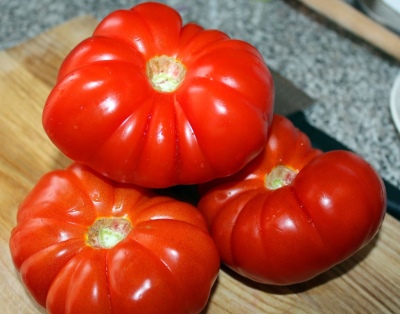
- Category: grade
- Growth type: indeterminate
- Appointment: universal
- Ripening period: mid-early
- Ripening time, days: 105-110
- Growing conditions: for open ground, for film greenhouses, for greenhouses
- Marketability: high
- Bush size: tall
- Bush height, cm: 180-200
- Bush characteristic: sprawling
Tomato Red figs can challenge many previously recognized varieties. But a good result can only be obtained by those gardeners who take into account the maximum information. And it is with an acquaintance with her that you should start.
Description of the variety
Red figs are a good indeterminate variety. This plant has a universal character, which is liked by almost all gardeners and summer residents. It is possible to grow such a culture in the open field, in film greenhouses, and in traditional greenhouses. Red fig bushes grow up to 1.8-2 m. They are distinguished by spreading.
The foliage of this variety is unusual. It is large in size, with feathery edges. The leaf surface is colored deep green. On the reverse side, they are much paler. It will be very difficult to confuse this look with something else.
The main qualities of the fruit
The berries of this variety have a deep red color, fully justifying their name. The size of the tomatoes will be very large. Their mass is 0.35-0.45 kg. The rounded shape predominates, and the characteristic ribs are formed at the base. Even a general acquaintance with such parameters convincingly proves the advantages of culture.
Taste characteristics
Those who have tasted such fruits note that a simple tomato flavor is typical for them. Moreover, it is also quite saturated. The pulp of tomatoes is fleshy and juicy. The reviews indicate her tenderness and sugariness. The skin is firm, but does not significantly affect the overall balance of taste.
Ripening and fruiting
Red figs are one of the typical mid-early varieties. He will keep up with it in 105-110 days. The harvest time is in July and August. The decisive importance, however, still remains with the real meteorological situation.
Yield
The collection of fruits can reach 7 kg per bush. Importantly, the crop is distinguished by high commercial characteristics.
The timing of planting seedlings and planting in the ground
It is necessary to sow seeds in containers in early March. Transplantation of ready-made seedlings into greenhouses is carried out in late April or early May. If you decide to grow tomatoes in the open field, you need to wait until the return frosts end and the soil warms up sufficiently. In addition, of course, they also look at the actual readiness of the plants themselves.

Growing tomato seedlings is an extremely important process, because it largely depends on whether the gardener will be able to harvest at all. All aspects must be taken into account, from seedbed preparation to planting in the ground.
Landing scheme
Such a tomato should be planted according to the 400x600 mm system. This is what the hybrid developers recommend. There can be no more than 3 bushes per 1 m2.

Growing and care
Removing stepchildren, giving the bushes a certain shape and tying them to supports are strictly required.The variety tolerates cooling. There is a chance of fruit cracking, but it is not high. It is important to understand that additional measures of protection against these factors only improve the result. Plants should be formed in 1 stem.
It is recommended to thoroughly fertilize the beds before planting. The basic top dressing can be superphosphate or wood ash. Using compost is also a good alternative. Stepping is carried out systematically. It is very important to tie the branches to the support (they are heavy and can easily fall or even completely collapse).
Seedlings are hardened for 6-8 days at 14 degrees. It is also recommended to feed it with the preparation "Krepysh". You can make such a top dressing even 2 or 3 times - it won't get any worse. During the growing season, adult plants are fed 3 times under the root and 3 times on the leaf. The first of the dressings is carried out when the seedlings are transplanted.
Next, you need to give the plants 7-10 days for full rooting. Only after this does it make sense to feed them again. For this purpose, a liquid mullein is used with a small addition of dolomite flour. This mixture is applied at 0.4 liters per 1 bush. Watering such a tomato is most effective with a drip method.




A plant needs different micronutrients at each stage of growth. All fertilizers can be divided into two groups: mineral and organic. Folk remedies are often used: iodine, yeast, bird droppings, eggshells.
It is important to observe the rate and period of feeding. This also applies to folk remedies and organic fertilizers.


Review overview
The bushes of red figs can reach enormous heights, and the berries have different sizes. The germination capacity of tomatoes is very high. Farmers' descriptions indicate that they hardly get sick. However, it is noted that when grown indoors, pests often attack the plantings.

























































































